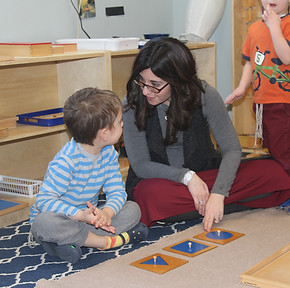.jpg)
What is Montessori?
Maria Montessori was born on August 31, 1870 in Italy. She became the first female physician in her country. In her medical practice, her clinical observations led her to analyze how children learn from what they find in their immediate environment.
Montessori founded the first Casa del Bambini, or “Children’s House,” in Rome in the year 1907. In the “Children’s House,” Montessori developed what ultimately became known as the Montessori Method of Education. The Montessori Method was based upon Dr. Montessori’s scientific observations of the children’s tireless interest in manipulating materials and almost effortless ability to absorb knowledge from their surroundings. Every piece of equipment, every exercise, every method Montessori developed was based on what she observed children do “naturally” by themselves, unassisted by adults. Montessori dedicated her life to furthering the self-creating process of the child through educational reform and teaching techniques based upon her discoveries.
Maria Montessori died in Holland in 1952, but her work continues. Today there are close to five thousand private and approximately two hundred public Montessori schools in the United States. Montessori schools exist in Canada, Russia, Japan, Israel, Australia, India and many other countries.
Why Montessori?
Recent studies show that many bright students are passive learners. They coast through school, earning high grades, but rarely pushing themselves to read material that hasn't been assigned, ask probing questions, challenge their teacher's opinions, or think for themselves. They typically want teachers to hand them the "right answer." The problem isn't with today's children but with today's schools. Children are as gifted, curious, and creative as they ever were when they're working on something that captures their interest and which they have voluntarily chosen to explore.
Montessori schools work to develop culturally literate children and nurture their fragile sparks of curiosity, creativity, and intelligence. They have a very different set of priorities from traditional schools, and a very low regard for mindless memorization and superficial learning. Montessori students may not memorize as many facts, but they do tend to become self-confident, independent thinkers who learn because they are interested in the world and enthusiastic about life, not simply motivated by getting a good grade.
.jpg)
חנוך לנער על פי דרכו
indvidualized learning -
.jpg)
Montessori schools are designed to help each student discover and develop her unique talents and possibilities. We treat each child as a unique, individual learner. In Montessori, children learn at their own pace, and learn in the ways that work best for them as individuals. The goal is to be flexible and creative in addressing each student as a unique individual. Learning the right answers may get a child through school, but learning how to become a life-long, independent learner will take her anywhere! Montessori teaches children to think, not simply to memorize, repeat back, and forget.
Rather than present students with loads of right answers, Montessori educators keep asking the right questions, and lead them to discover the answers for themselves. Learning becomes its own reward, and each success fuels a desire to discover even more. Older students are encouraged to do their own research, analyze what they have found, and come to their own conclusions. Teachers encourage children to think for themselves and become actively engaged in the learning process.
freedom of movement
Young children touch and manipulate everything in their environment. In a sense, the mind is hand made, because through movement and touch, the child explores, manipulates, and builds up a storehouse of impressions about the physical world around him. Children learn by doing, and this requires movement and spontaneous investigation. In Montessori classrooms, children are free to move about, working alone or with others at will. They may select any activity and work with it as long as they wish, so long as they do not disturb anyone or damage anything and they put it back where it belongs when they are finished.
Many exercises, especially at the early childhood level, are designed to draw the child's attention to the sensory properties of objects within the environment: size, shape, color, texture, weight, smell, sound, etc. Gradually, the child learns to pay attention, seeing more clearly small details. He has begun to observe and appreciate his environment. This is a key in helping the child discover how to learn.
Freedom is a second critical issue as the child begins to explore. Our goal is less to teach him facts and concepts, but rather to help him fall in love with the process of

focusing his complete attention on something and solving its riddle with enthusiasm and even joy. Work assigned by the adult rarely results in such enthusiasm and interest as does work that a child freely chooses for himself. The prepared environment of the Montessori class is a learning laboratory in which the child is allowed to explore, discover, and select his own work. The independence that the child gains is not only empowering on a social and emotional basis. It is also intrinsically involved with helping the child become comfortable and confident in his ability to master the environment, ask questions, puzzle out the answer, and learn without needing to be spoon-fed by an adult.

a prepared enviroment
Montessori classrooms tend to fascinate both children and their parents. They are normally bright, warm, and inviting, filled with plants, animals, art, music, and books. There are interest centers filled with intriguing learning materials, fascinating mathe-
matical models, maps, charts, fossils, historical artifacts, scientific apparatus, perhaps a small natural-science museum, and animals that the children are raising. A Montessori classroom is commonly referred to as a prepared environment. This name reflects the care and attention that is given to creating a learning environment that will reinforce the children's independence and intellectual development.
One should not expect to find rows of desks in a Montessori classroom. The rooms are designed to facilitate student discussion and stimulate collaborative learning. One glance, and it is clear that children feel comfortable and safe. Students are typically found scattered around the classroom, working alone or with one or two others. They tend to become so involved in their work that visitors are immediately struck by the peaceful atmosphere. It may even take a moment to spot the teachers within the environment. They will be found working with one or two children at a time, advising, presenting a new lesson, or quietly observing the class at work.
Montessori Curriculum
The Montessori classroom is organized into several curriculum areas, usually including: language arts (reading, literature, grammar, creative writing, spelling, and handwriting), mathematics and geometry, everyday living skills, sensory awareness exercises and puzzles, geography, history, science, art, music, and movement. Most rooms will include a classroom library. Each area is made up of one or more shelving units, cabinets, and display tables with a wide variety of materials on open display, ready for use as the children select them. The Montessori curriculum is organized into a spiral of integrated studies, rather than a traditional model in which the curriculum is compartmentalized into separate subjects, with given topics considered only once at a specific grade level.
In the early years, lessons are introduced simply and concretely and are reintroduced several times over succeeding years at increasing degrees of abstraction and complexity. The course of study uses an integrated thematic approach that ties the separate disciplines of the curriculum together into studies of the physical universe, the world of nature, and the human experience. Literature, the arts, history, social issues, political science, economics, and science all complement one another.

This integrated approach is one of Montessori's great strengths. As an example, when students study Africa, they also read African folktales, create African masks and make African block print dashikis, learn Swahili songs and traditional folk dances, and study the ecosystems, flora, fauna, and natural resources of the continent.
Meeting the needs of each child
Montessori teachers do more than present curriculum. The secret of any great teacher is helping learners arrive at a point that their minds and hearts are open and they are ready to learn, where the motivation is not focused on getting good grades but, instead, learning for the sake of learning. As parents know their own children's learning styles and temperaments, teachers, too, develop this sense of each child's uniqueness by developing a relationship over a period of years with the child and her parents. Dr. Montessori believed that teachers should focus on the child as a person, not on the daily lesson plan.
Montessori nurtures and inspires the human potential, leading children to ask questions, think for themselves, explore, investigate, and discover. Our ultimate objective is to help them to learn how to learn independently, retaining the curiosity, creativity, and intelligence with which they were born. Montessori teachers don't simply present lessons; they are facilitators, mentors, coaches, and guides. Traditionally, teachers tell us that they "teach students the basic facts and skills that they will need to succeed in the world." Studies show that in many classrooms, as much as 40 percent of the day may be spent on discipline and classroom management.
Montessori educators play a very different role. Wanting to underscore the different role played by adults in her schools, Dr. Montessori used the title "director" or "directress" instead of "teacher." In Italian, the word implies the role of the coordinator or administrator of an office or factory. Today, many Montessori schools prefer to call their teachers "guides." Whatever they are called, Montessori teachers are rarely the center of attention, for this is not their classroom; it is the "Children's House." Normally, Montessori teachers will not spend much time working with the whole class at once.
Their primary role is to prepare and maintain the physical, intellectual, and social/emotional environment within which the children will work. Certainly, a key aspect of this is the selection of intriguing and developmentally appropriate opportunities for learning to meet the needs and interests of each child in the class.
Montessori guides have four principle goals:
-
to awaken the child's spirit and imagination;
-
to encourage his normal desire for independence and high sense of self-esteem;
-
to help him develop the kindness, courtesy, and self- discipline that will allow him to become an exemplary member of society; and
-
to help the child learn how to observe, question, and explore ideas independently.

_JPG.jpg)
Montessori teachers rarely present a lesson to more than a handful of children at one time, and they limit lessons to brief, efficient presentations. The goal is to give the children just enough to capture their attention and spark their interest, intriguing them enough that they will come back on their own to work with the materials. Lessons center around the most clear and simple information necessary for the children to do the work on their own: the name of the material, its place on the shelf, the ground-rules for its use, and some of the possibilities inherent within it. Montessori guides closely monitor their students' progress, keeping the level of challenge high. Because they normally work with each child for two or three years, guides get to know their students' strengths and weaknesses, interests, and anxieties extremely well. Montessori guides often use the children's interests to enrich the curriculum and provide alternate avenues for accomplishment and success. Elementary level Montessori students rarely work from textbooks. Instead they learn to use the library and internet to gather information into reports and presentations to share with their friends. Naturally, they also do a great deal of hands-on, project oriented learning that makes their studies come alive. Dr. Montessori often spoke of "spontaneous activity in learning", and this is what Montessori teachers constantly seek to cultivate in their classrooms.
_JPG.jpg)
